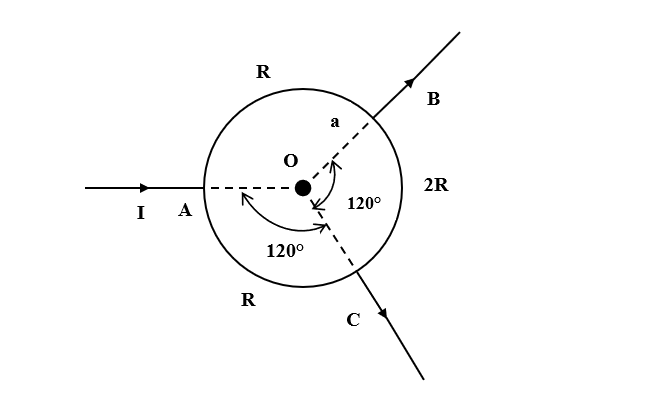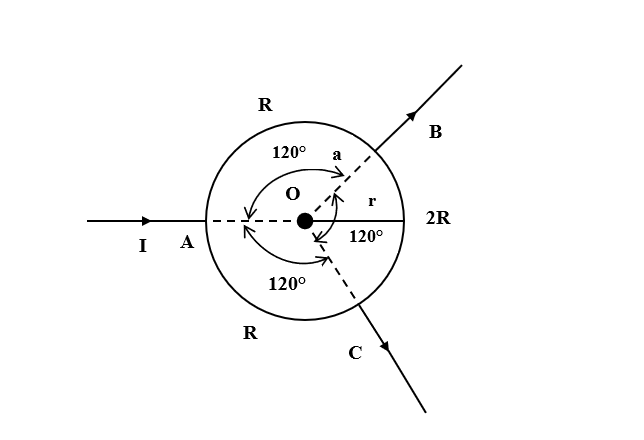
The resistances of three parts of a circular loop are as shown in the figure. The magnetic field at the center O is (current enters at A and leaves at B and C as shown in the figure.)

A. $\dfrac { { \mu }_{ 0 }I }{ 6a }$
B. $\dfrac { { \mu }_{ 0 }I }{ 3a }$
C. $\dfrac {2}{3} \dfrac { { \mu }_{ 0 }I }{ a }$
D. $zero$

Answer
542.1k+ views
Hint: From the figure we can say that the current I get equally divided between AB and AC. With the help of these currents find the potential difference across AB and AC. From the potential difference across AB and AC you will get the potential difference and the current flowing across BC. Then, use the formula for magnetic field and find the magnetic field due to AC, AB and BC. Adding the magnetic fields due to AB, AC and BC will give the net magnetic field. This obtained value will be the magnetic field at the center O.
Complete answer:

Let the radius of the circular loop be r
It is given that the current entering from A is I.
The circuit is symmetric so the current flowing from A to B will be equal to the current flowing from A to C.
Current from A to B= Current from A to C= $\dfrac {I}{2}$
Let the potential at A be ${V}_{A}$
Similarly, at B and C be ${V}_{B}$ and ${V}_{C}$ respectively.
The potential difference between A and B can be given by,
${V}_{B}-{V}_{A}= \dfrac {I}{2}R$
$\Rightarrow {V}_{B}= {V}_{A}+ \dfrac {I}{2}R$ …(1)
Similarly, the potential difference between A and C can be given by,
${V}_{C}-{V}_{A}= \dfrac {I}{2}R$
$\Rightarrow {V}_{C}= {V}_{A}+ \dfrac {I}{2}R$ …(2)
From the equation. (1) and (2) we get,
${V}_{B}= {V}_{C}$
Thus, as the potential at B and C are the same, no current will flow from B to C.
We know, Magnetic field is given by,
$B= \dfrac {\theta}{360°}. \dfrac {{\mu}_{0}I}{2\pi r}$
Magnetic field due to AC by substituting the values in above equation is given by,
${B}_{AC}= \dfrac {120°}{360°}. \dfrac {{\mu}_{0}I}{4\pi r}$
$\Rightarrow {B}_{AC}= \dfrac {1}{3}. \dfrac {{\mu}_{0}I}{4\pi r}$
Now, applying the right hand thumb rule, the direction of the magnetic field is outwards.
Similarly, Magnetic field due to AB is given by,
${B}_{AB}= \dfrac {120°}{360°}. \dfrac {{\mu}_{0}I}{4\pi r}$
$\Rightarrow {B}_{AB}= \dfrac {1}{3}. \dfrac {{\mu}_{0}I}{4\pi r}$
Applying right hand thumb rule, the magnetic field due to AB is inwards.
Similarly, Magnetic field due to BC is given by,
${B}_{BC}= \dfrac {120°}{360°}. \dfrac {{\mu}_{0} \times 0}{2\pi r}$
$\Rightarrow {B}_{BC}= 0$
The magnitude of the magnetic field due to AB and AC are the same but their direction is opposite.
$\Rightarrow {B}_{AC}= -{B}_{AB}$ …(3)
Thus, the net magnetic field is given by,
${B}_{net}={B}_{AC}+{B}_{AB}+{B}_{BC}$
Substituting equation. (3) and value of ${B}_{BC}$ in above equation we get,
${B}_{net}=-{B}_{AB}+{B}_{AB}+0$
$\Rightarrow {B}_{net}= 0$
Thus, the magnetic field at the center O is zero.
So, the correct answer is option D i.e. zero.
Note:
For solving this question, we have used the right hand thumb rule. Students should not get confused between the right-hand thumb rule and Fleming’s right hand rule. According to Fleming’s right hand rule, the thumb indicates the direction of force, the forefinger indicates the direction of the magnetic field and the middle finger represents the direction of current. Whereas according to right hand thumb rule, the thumb indicates the direction of current and the direction in which the fingers wrap gives the direction of magnetic field.
Complete answer:

Let the radius of the circular loop be r
It is given that the current entering from A is I.
The circuit is symmetric so the current flowing from A to B will be equal to the current flowing from A to C.
Current from A to B= Current from A to C= $\dfrac {I}{2}$
Let the potential at A be ${V}_{A}$
Similarly, at B and C be ${V}_{B}$ and ${V}_{C}$ respectively.
The potential difference between A and B can be given by,
${V}_{B}-{V}_{A}= \dfrac {I}{2}R$
$\Rightarrow {V}_{B}= {V}_{A}+ \dfrac {I}{2}R$ …(1)
Similarly, the potential difference between A and C can be given by,
${V}_{C}-{V}_{A}= \dfrac {I}{2}R$
$\Rightarrow {V}_{C}= {V}_{A}+ \dfrac {I}{2}R$ …(2)
From the equation. (1) and (2) we get,
${V}_{B}= {V}_{C}$
Thus, as the potential at B and C are the same, no current will flow from B to C.
We know, Magnetic field is given by,
$B= \dfrac {\theta}{360°}. \dfrac {{\mu}_{0}I}{2\pi r}$
Magnetic field due to AC by substituting the values in above equation is given by,
${B}_{AC}= \dfrac {120°}{360°}. \dfrac {{\mu}_{0}I}{4\pi r}$
$\Rightarrow {B}_{AC}= \dfrac {1}{3}. \dfrac {{\mu}_{0}I}{4\pi r}$
Now, applying the right hand thumb rule, the direction of the magnetic field is outwards.
Similarly, Magnetic field due to AB is given by,
${B}_{AB}= \dfrac {120°}{360°}. \dfrac {{\mu}_{0}I}{4\pi r}$
$\Rightarrow {B}_{AB}= \dfrac {1}{3}. \dfrac {{\mu}_{0}I}{4\pi r}$
Applying right hand thumb rule, the magnetic field due to AB is inwards.
Similarly, Magnetic field due to BC is given by,
${B}_{BC}= \dfrac {120°}{360°}. \dfrac {{\mu}_{0} \times 0}{2\pi r}$
$\Rightarrow {B}_{BC}= 0$
The magnitude of the magnetic field due to AB and AC are the same but their direction is opposite.
$\Rightarrow {B}_{AC}= -{B}_{AB}$ …(3)
Thus, the net magnetic field is given by,
${B}_{net}={B}_{AC}+{B}_{AB}+{B}_{BC}$
Substituting equation. (3) and value of ${B}_{BC}$ in above equation we get,
${B}_{net}=-{B}_{AB}+{B}_{AB}+0$
$\Rightarrow {B}_{net}= 0$
Thus, the magnetic field at the center O is zero.
So, the correct answer is option D i.e. zero.
Note:
For solving this question, we have used the right hand thumb rule. Students should not get confused between the right-hand thumb rule and Fleming’s right hand rule. According to Fleming’s right hand rule, the thumb indicates the direction of force, the forefinger indicates the direction of the magnetic field and the middle finger represents the direction of current. Whereas according to right hand thumb rule, the thumb indicates the direction of current and the direction in which the fingers wrap gives the direction of magnetic field.
Recently Updated Pages
Why are manures considered better than fertilizers class 11 biology CBSE

Find the coordinates of the midpoint of the line segment class 11 maths CBSE

Distinguish between static friction limiting friction class 11 physics CBSE

The Chairman of the constituent Assembly was A Jawaharlal class 11 social science CBSE

The first National Commission on Labour NCL submitted class 11 social science CBSE

Number of all subshell of n + l 7 is A 4 B 5 C 6 D class 11 chemistry CBSE

Trending doubts
Differentiate between an exothermic and an endothermic class 11 chemistry CBSE

10 examples of friction in our daily life

One Metric ton is equal to kg A 10000 B 1000 C 100 class 11 physics CBSE

Difference Between Prokaryotic Cells and Eukaryotic Cells

1 Quintal is equal to a 110 kg b 10 kg c 100kg d 1000 class 11 physics CBSE

State the laws of reflection of light




